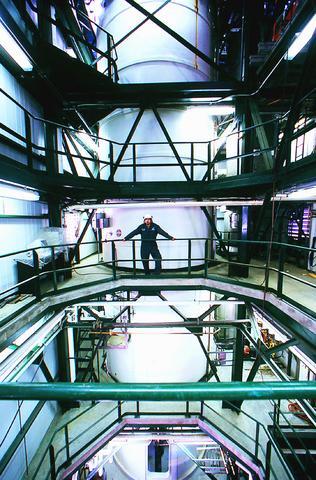When oil prices rise, public interest in alternative energy often does too. Tapping into renewable sources of power like wind, solar power and hydrogen, which are inexhaustible but far from inexpensive, seems to make more commercial sense when crude oil costs almost US$48 a barrel.
But the logic is evidently escaping Wall Street. Many companies involved in alternative energy have missed out on the rally that has lifted shares of oil and gas companies.

PHOTO: THE NEW YORK TIMES
Some investors, particularly advocates of what is known as socially responsible investing, expect the cost gap to narrow. They say that producing energy from renewable sources is becoming cheaper, while fossil fuels will become more expensive as supplies dwindle, long after the current pressures that have been pushing prices higher have receded.
Those advocates also say that concerns about pollution and climate change make alternative energy more politically palatable than energy from conventional sources. In many countries, they say, that should help producers benefit from government subsidies and ambitious production targets.
But skeptics closer to the investment mainstream argue that renewable energy will not become commercially viable for many years. In the meantime, they warn, these industries will have to depend on continual new financing and, as a result, are best avoided.
"The overriding issue is that the economics have to work, and for many companies that hasn't been the case," said Wenhua Zhang, an analyst at T. Rowe Price in Baltimore. "These are capital-intensive industries. There are very few of them where you don't have to spend a lot of money."
Alternative energy sources typically require huge infrastructure investment to deliver power to electricity grids, or to cars in the case of hydrogen as a substitute for gasoline.
"Energy is not like other technologies, where you can get started for US$15 million," Zhang said, referring to the dot-coms that proliferated in the late 1990s. "You need half a billion."
Portfolio managers and small investors may be reluctant to dip into their pockets when any payoff may be years away, but some big-name industrial companies that can afford to be patient have been making significant investments in alternative energy. Ford Motor and DaimlerChrysler recently agreed to acquire part of the vehicular fuel-cell business of Ballard Power Systems.
General Electric is one of the world's largest producers of wind turbines and is heavily involved in solar power, too, as are the Japanese companies Matsushita Electric Industrial and Kyocera and the oil producers Royal Dutch/Shell and BP.
"GE is likely to become the largest alternative energy company in the world in a short time," said James Cameron, a founding partner of Climate Change Capital, a venture capital firm in London that specializes in alternative energy. The investments by GE and other multinational companies "are signs that the industry is about to grow up," Cameron said.
He added that pressure on pension plans to invest in socially acceptable ways would bring more money to the sector.
For now, though, many investors remain reluctant to commit capital to companies that will not show profits for a long time, if ever. Yet Charlie Thomas, a manager of environmental funds at Jupiter Asset Management in London, pointed out that some makers of wind turbines were already in the black, including two of his favorites, Vestas Wind Systems of Denmark and Gamesa of Spain.
"Wind is becoming more and more interesting," Thomas said. With oil and gas prices so high, he added, "onshore wind is just about the most efficient source of energy and is providing increasing competition against fossil-fuel energy sources."
But stocks of wind companies have not performed particularly well during the spike in crude prices over the last few months. One reason, Thomas said, is that investors jumped the gun last year, driving prices so high that "alternative energy became a bubble issue." They have spent the last several months digesting last year's gains.
Thomas advised sticking with wind companies, like Vestas and Gamesa, that have large market shares. Vestas has close to one-third of the global wind turbine business. The stock trades at about 16 times his estimate of 2005 earnings.
Gamesa is even cheaper, he said, about 12 times estimated 2005 earnings, after rising 67 percent in the last year, making it one of the best performers among energy companies, alternative and ordinary alike.
"Gamesa has done very well in the last year," Thomas said. "They make good turbines at the right prices." The company's main markets are Spain and Latin America, and sales to China are increasing, he noted.
Timothy O'Brien, manager of the Evergreen Utility and Telecommunications fund, declines to invest directly in wind technology, saying that "an awful lot of money has been poured into this, and the returns have been de minimus." But he does invest in a utility that invests heavily in wind: FPL, the holding company for Florida Power and Light and other companies. It owns wind turbines across the country and around the world and sells the power they generate to local utilities.
"One reason we own it is the wind play," O'Brien said.
O'Brien also owns three utilities -- Entergy, Exelon and Dominion Resources -- that produce much of their power from nuclear generators bought cheaply in the 1990s. They look to be especially good bargains now, he said, because prices for natural gas, used to produce electricity, have risen so high.
"They bought nuclear plants at what looked like deeply discounted prices at the time," he said of the utilities. "Now they look like extremely advantageous prices. The higher natural-gas prices go, the more money these guys make."
Producers of solar power have further to travel on the path to commercial viability than producers of other alternative energy sources, Thomas said, but he has found a few small companies that he said are successfully occupying niches in the area. They include Carmanah Technologies, a Canadian company that incorporates solar panels into marine lights and bus shelters; Solar Integrated Technologies, a British company that makes solar roofing materials that can be unrolled like mats; and Romag, a British glass maker that BP has contracted to place solar panels into glass panes.
Thomas is less optimistic about companies that make fuel cells, saying that he has cut his investment in the sector in the last year. "Most haven't got earnings at this stage," he said. "Companies that haven't got sustainable earnings, and are just bets on future growth, can suffer."
That is why Zhang is not willing to make such a bet. "Long term, there will be breakthroughs that make these technologies commercially viable," he said, "but so far it's more science fair than reality."

The combined effect of the monsoon, the outer rim of Typhoon Fengshen and a low-pressure system is expected to bring significant rainfall this week to various parts of the nation, the Central Weather Administration (CWA) said. The heaviest rain is expected to occur today and tomorrow, with torrential rain expected in Keelung’s north coast, Yilan and the mountainous regions of Taipei and New Taipei City, the CWA said. Rivers could rise rapidly, and residents should stay away from riverbanks and avoid going to the mountains or engaging in water activities, it said. Scattered showers are expected today in central and

COOPERATION: Taiwan is aligning closely with US strategic objectives on various matters, including China’s rare earths restrictions, the Ministry of Foreign Affairs said Taiwan could deal with China’s tightened export controls on rare earth metals by turning to “urban mining,” a researcher said yesterday. Rare earth metals, which are used in semiconductors and other electronic components, could be recovered from industrial or electronic waste to reduce reliance on imports, National Cheng Kung University Department of Resources Engineering professor Lee Cheng-han (李政翰) said. Despite their name, rare earth elements are not actually rare — their abundance in the Earth’s crust is relatively high, but they are dispersed, making extraction and refining energy-intensive and environmentally damaging, he said, adding that many countries have opted to

FORCED LABOR: A US court listed three Taiwanese and nine firms based in Taiwan in its indictment, with eight of the companies registered at the same address Nine companies registered in Taiwan, as well as three Taiwanese, on Tuesday were named by the US Department of the Treasury’s Office of Foreign Assets Control (OFAC) as Specially Designated Nationals (SDNs) as a result of a US federal court indictment. The indictment unsealed at the federal court in Brooklyn, New York, said that Chen Zhi (陳志), a dual Cambodian-British national, is being indicted for fraud conspiracy, money laundering and overseeing Prince Holding Group’s forced-labor scam camps in Cambodia. At its peak, the company allegedly made US$30 million per day, court documents showed. The US government has seized Chen’s noncustodial wallet, which contains

SUPPLY CHAIN: Taiwan’s advantages in the drone industry include rapid production capacity that is independent of Chinese-made parts, the economic ministry said The Executive Yuan yesterday approved plans to invest NT$44.2 billion (US$1.44 billion) into domestic production of uncrewed aerial vehicles over the next six years, bringing Taiwan’s output value to more than NT$40 billion by 2030 and making the nation Asia’s democratic hub for the drone supply chain. The proposed budget has NT$33.8 billion in new allocations and NT$10.43 billion in existing funds, the Ministry of Economic Affairs said. Under the new development program, the public sector would purchase nearly 100,000 drones, of which 50,898 would be for civil and government use, while 48,750 would be for national defense, it said. The Ministry of